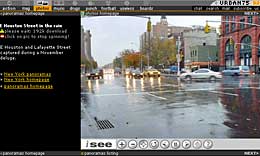|
|
 Creating photographic panoramas with PhotoVista
Creating photographic panoramas with PhotoVista
Stitch your photos together to create interactive landscapes
By Mike Slocombe for Internet Magazine, June 2004
There's no denying that a good photograph is a great way of illustrating a scene, but with an interactive panorama you can feel like you're almost there!
Building interactive panoramas used to be the preserve of pixel-pushing, graphics whizzkids, but modern software makes the job of stitching your images together an absolute breeze.
You won't need a degree in advanced anoraking to get great results!
 You won't need any fancy hardware either. In fact, any old camera will do - even a disposable one - but with each panorama needing anything up to 15 images, the hefty processing costs and arduous scanning might make a digital camera seem the most attractive option.
You won't need any fancy hardware either. In fact, any old camera will do - even a disposable one - but with each panorama needing anything up to 15 images, the hefty processing costs and arduous scanning might make a digital camera seem the most attractive option.
Taking the pictures is fairly straightforward process. Although a tripod helps it's not essential - all you have to do is try and hold the camera level, get your hips a-swivelling and take a series of overlapping pictures in a big circle.
Once you've captured your panoramic scene, you'll need to upload the images to your PC and then feed them into your preferred panorama package, making sure you've got the images the right way up and in the right order.
Then you have to tell the program what lens you used so it knows how to blend the images together and compensate for any lens distortion.

Although one or two packages insist that wide angle lens are used, most are fairly flexible, and whatever's stuck on the front of your camera will do just fine.
Although some graphics packages (like Photoshop Elements) offer basic panorama stitching tools, if you want all the interactive bells and whistles, you'll need to use a dedicated panorama software package.

These vary enormously in price, but they all perform the same basic function of using clever software algorithms to line up and blend a series of photographs into one long, seamless image.
This image can then be uploaded to the web, and either displayed as one long strip or viewed in an interactive interface, using proprietary browser plug-ins, Flash or Java applets.
Most of these interfaces offer simple tools to allow viewers to zoom in and out and pan around the scene - but the images do get progressively grainier at very high levels of zoom.

The more advanced software packages add extra features like the ability to create spherical panoramas. These add extra vertical information, letting viewers look up to the sky or gaze at the photographer's feet, if so desired.
Spherical panoramas are increasing in popularity although they can be quite fiddly to set up.
You can also create a more immersive environment by including clickable 'hot spots' within panoramas. These let viewers click on objects within the scene and explore them in a separate panorama (you click on the door of a building you'd be taken to an interior panorama).
For this walkthrough, we're going to be using the excellent PhotoVista software, which is - in our opinion - one of the slickest and easiest panorama packages around.
More info: Comprehensive review of panorama packages
|

